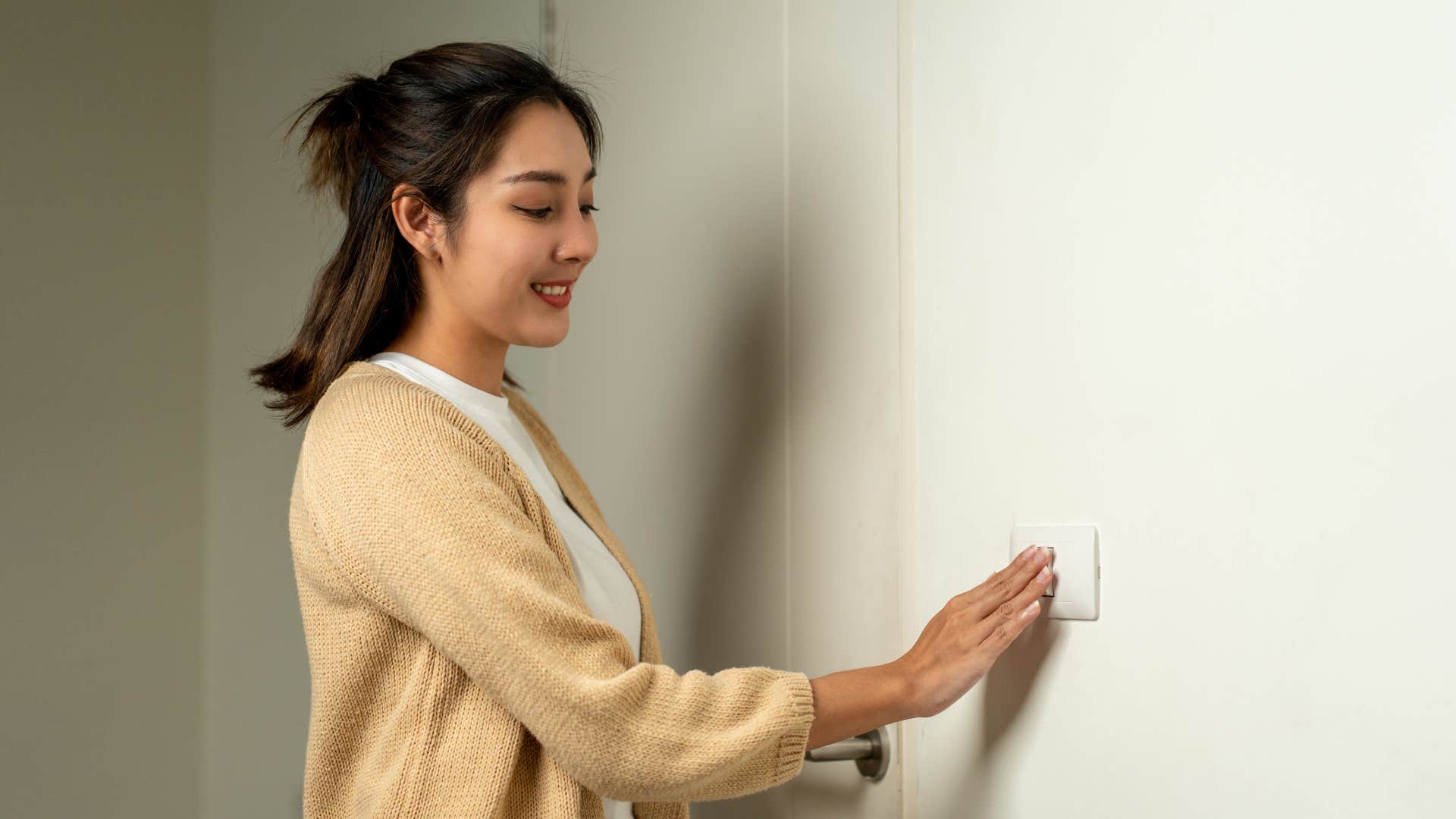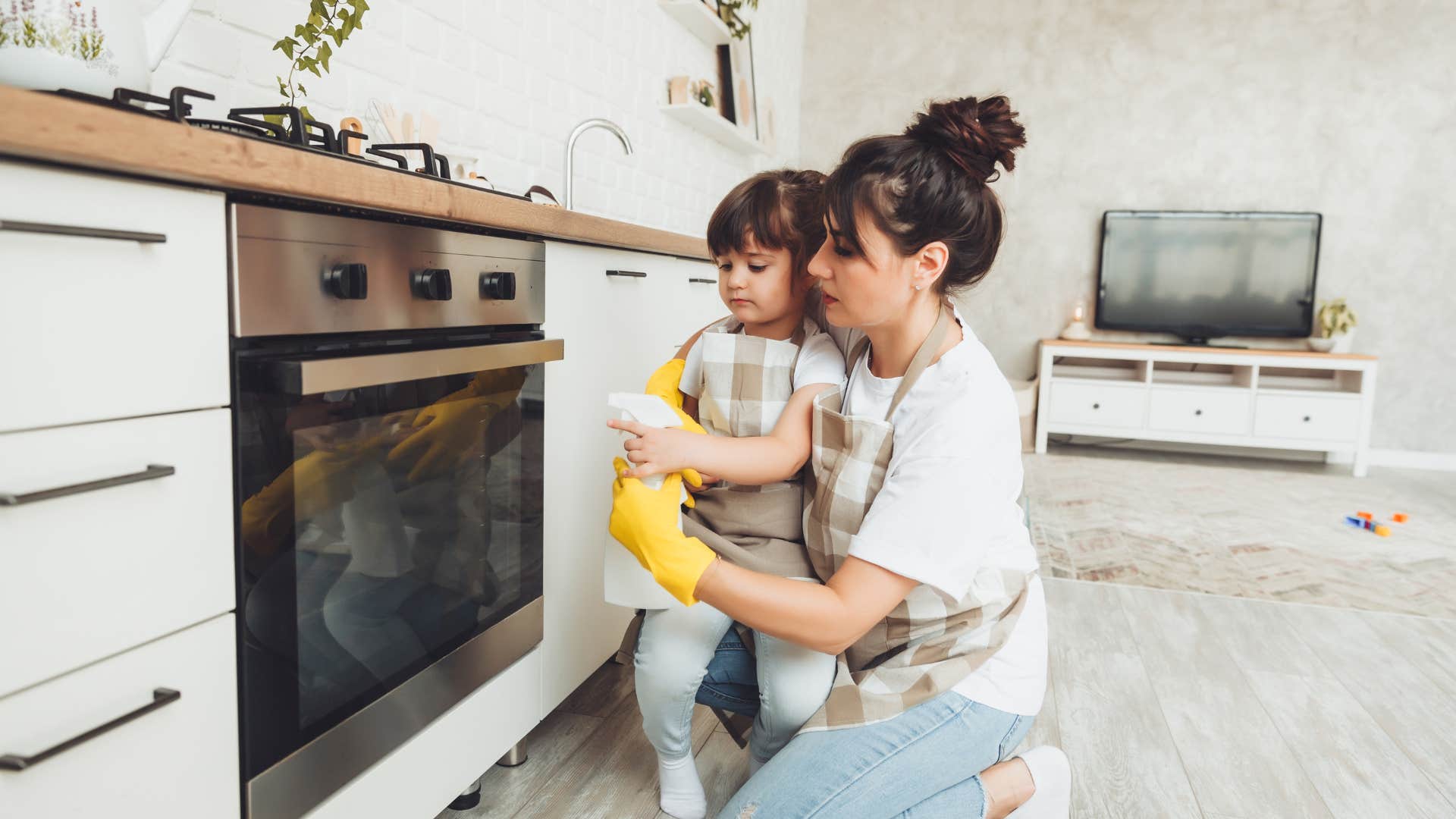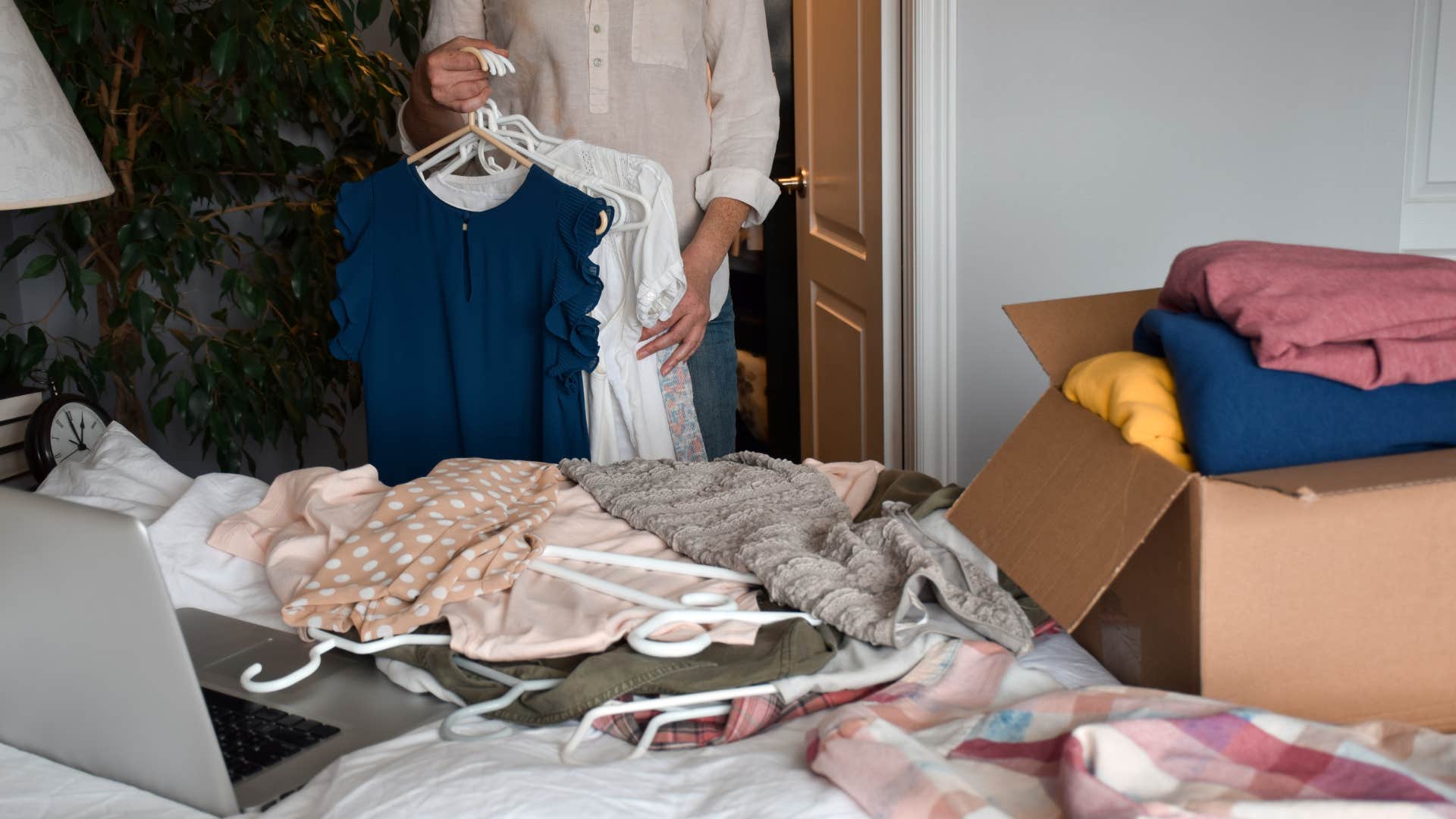11 Things That Make Frugal People Cringe When They Visit Someone’s Home
Your frugal friend has definitely side-eyed your thermostat.
 Balchugova Maria | Shutterstock
Balchugova Maria | Shutterstock There are some very specific things about a home that make frugal people cringe. Being very particular is just part of a frugal perosn’s nature. They save as much money as they possibly can, and they expect everyone else to have those same goals. When they see an excess of money being spent — or worse, wasted — it just rubs them the wrong way. This can make visiting other people’s homes complicated because not everyone has the same standards they do when it comes to money.
Because of this, they might feel frustrated or even cringe when in someone else’s house. When they see other people spending money frivolously, it will definitely bother them, and nowhere is the amount of money someone spends more evident than in their own home. Financial content creator Tae Kim admitted that a lot of frugal people are afraid of spending money, but said this isn’t the right mindset to have. So, when a frugal person visits someone’s home and notices that they’re spending money, it might be best to accept that it’s what works for them. That doesn’t make it any more comfortable for them, though. Here are the things that make frugal people cringe when they visit someone else’s home.
1. A giant TV filled with too many streaming subscriptions
 Stock-Asso | Shutterstock
Stock-Asso | Shutterstock
The first thing that would make a frugal person cringe when they visit someone’s home is a huge TV with plenty of streaming services loaded on it. In the culture we live in, TVs are usually front and center in people’s homes, so it would be one of the easiest things to spot. A giant flatscreen would be even more ubiquitous. And, the thing about streaming subscriptions is everyone assumes you don’t use all of the ones you have, so you must be wasting money. A big smart TV with all of your streaming services on it would make a frugal person roll their eyes for sure.
Streaming might have seemed like a great option during the coronavirus pandemic when everyone was isolating in their homes and had nothing else to do, but statistics show that its use has not slowed down. In January 2024, Bank of America Institute found that spending on streaming services was up more than 70% since 2021. Clearly, people have no intention of cutting back on their streaming subscriptions.
Whether or not people actually come out better financially is unclear. NerdWallet writer Laura McMullen said that cable typically costs between $45 and $145. If someone only had one streaming service, they would obviously be saving money, but with multiple subscriptions, they might end up spending about the same amount of money.
This would bother a frugal person endlessly. They wouldn’t be able to fathom spending so much money on different streaming services that all offer similar choices. The super nice, super huge TV would be like the cherry on top — in the worst way. They would immediately wonder just how much that person is spending and whether it is worth it or not. And, a frugal person would probably conclude that it is in fact not worth it.
2. Lights left on in empty rooms
 GBJSTOCK | Shutterstock
GBJSTOCK | Shutterstock
Few things would make a frugal person cringe more than the sight of lights left on in rooms that aren’t even occupied. Obviously, a house has to have some lights on if someone is home, but having the whole place lit up would seriously bother a frugal person. All they would be able to think about would be the cost of the electricity bill skyrocketing with each unnecessary light. Someone who’s not frugal wouldn’t think much of this, though, and would simply forget to turn the lights off when they leave a room.
According to the U.S. Department of Energy, the exact amount of money you could save by turning a light off depends both on the cost of electricity and the type of lightbulb being used. They instructed consumers to calculate the kilowatt-hours (kWh) that a bulb uses with the time it is turned on and the wattage of the bulb, then multiply that by their electricity charge for kWh.
While there’s no way to calculate the exact amount of money someone is wasting by leaving the lights on unnecessarily without being given specifics, it’s common knowledge that it certainly does save some money to turn them off. A frugal person will see lights left on as a complete waste and wish that person would be more mindful of their energy usage. Still, some people are just known for leaving lights on all the time.
3. Single-use paper products everywhere
 frantic00 | Shutterstock
frantic00 | Shutterstock
If there’s one thing frugal people love, it’s things that can be reused. They keep all kinds of washable containers on hand, along with dish cloths that can be used for cleaning. And, of course, they hardly ever opt for plastic silverware or paper plates. But, some people prefer the convenience of paper products that can just be used once and then thrown away. They don’t have to be washed, and there’s always a fresh, clean one on hand as long as you bought enough.
That, of course, is the problem for frugal people — they can’t imagine spending money on things that just get used once and then thrown away. Statista reported that American households spent approximately $114.41 on paper products like paper towels, toilet paper, and napkins in 2022. Obviously, there’s really no substitute for toilet paper, but cloth towels can be used instead of paper towels, and reusable cloth napkins can even be used at mealtime.
A frugal person would be shocked and dismayed to watch someone repeatedly use a single-use product that gets thrown out as soon as it has served its purpose. That’s the equivalent of throwing away money to them. To them, it would be much wiser to use something reusable. They’d likely have trouble eating in the home of someone who’s not frugal and accepting their paper plates and napkins.
4. Closets bursting with clothes
 Wayhome Studio | Shutterstock
Wayhome Studio | Shutterstock
Being frugal doesn’t automatically mean you’re a minimalist; it just means you’re more conscious of how much money you spend and try to save what you can. For that reason, frugal people don’t spend a ton of money on clothes. They recognize that you don’t need an endless wardrobe supply to put nice outfits together. You can only wear one outfit at a time, after all. Closets don’t need to be bursting with clothes for you to dress nicely.
People who aren’t frugal don’t really stand by this belief. They like nice things, and cute clothes are a part of that. Of course, if you’ve got someone on your hands who enjoys fashion, this just compounds the issue. Writing for The Motley Fool, Emma Newbery said the average U.S. household spends $1,434 annually on “clothes and related services.” This is roughly 2.3% of a household’s yearly spending.
Frugal people would gawk at spending nearly $1,500 on clothes each year. That’s a lot of money that could be put toward something more useful or, even better, saved. For this reason, frugal people may frequent second-hand shops and consignment stores. They’ll also likely buy less, recognizing that they don’t need as great of a quantity of clothes as some people think they do. And they will certainly not be clothes shopping for fun when they have nothing else to do.
5. Too much unneeded or expensive decor
 Dmytro Zinkevych | Shutterstock
Dmytro Zinkevych | Shutterstock
Furniture is considered a necessity in our culture. We expect to have a comfortable place to sit in a home, whether it’s our own or someone else’s. Whether someone spends too much money on furniture can certainly be debated, but it’s tricky to do so since it’s thought of as necessary. Also, it can be hard to tell how much furniture costs just by looking at it. One thing that’s not a necessity, though, is the little pieces of decor that make up a room around the furniture.
Some people can make things that are inexpensive or even things they DIY look really nice, and you could mistake them for something pricier. Often, though, if decor looks expensive, that’s because it is. Frugal people can’t stand to see uber fancy decor filling a home because they know it probably cost a lot. Instead, they’re fine just sticking to items from Target or Walmart and making the most of them.
According to Home Advisor, the average cost to decorate and furnish a home is $16,000, but the low-to-high-end range can be anywhere from $3,500 to $95,000. Of course, that is the cost of both furnishing and decorating, and furniture is going to cost a lot more than decor pieces. Still, even the low-end is several thousand dollars. A frugal person would never spend that much on decorating their home, and would cringe to find out someone else actually did.
6. All new appliances
 Inna photographer | Shutterstock
Inna photographer | Shutterstock
Another thing that would make a frugal person cringe when visiting someone’s home is all new appliances. Of course, something could have happened that required the purchase of new appliances. But all of the old appliances breaking at the exact same time seems pretty unlikely. The most probable answer is that someone just decided they wanted new appliances. A frugal person would never dream of replacing their appliances that are working perfectly fine just for the sake of getting new ones to achieve some sort of aesthetic.
The cost of appliances will depend on exactly what you’re replacing, but Home Advisor estimated that a completely new set would cost someone about $10,875. That is a big chunk of change that could be spent on something else that’s actually needed in the immediate future, or money that could go in an emergency fund. That makes buying all new appliances just because you can seem a little frivolous, especially from the point of view of a frugal person.
Someone frugal would never replace all of their appliances for no reason, or just to make sure they match and look just so. If something absolutely had to be replaced, they’d take care of it, but replacing everything without a very good reason would be out of the question. Frugal people quite literally live by the maxim, “If it ain’t broke, don’t fix it.” They would see no reason to replace appliances that still work.
7. Leftovers getting tossed out
 Gorodenkoff | Shutterstock
Gorodenkoff | Shutterstock
A frugal person would definitely cringe if they saw someone throw away leftovers. Tupperware was invented for a reason, after all. People who aren’t frugal might think nothing of throwing out leftovers because they don’t care about waste, but their frugal friends definitely do. Waste is one of the worst possible things for a frugal person to witness because it’s not only wasting resources but also wasting money.
The U.S. Environmental Protection Agency said that a family of four usually wastes $3,000 on food they don’t eat annually. Whether that problem occurs in shopping, storage, or cooking is an individual matter for each family. As the EPA pointed out, it’s important to store food properly so that it remains safe to consume. This includes leftovers, which can last for a number of days depending on the food.
By not saving leftovers, people really are just throwing perfectly good food that could still be eaten away. Frugal people will see this as financially reckless. (Not to mention how many people who don’t have enough to eat that could be fed with that food.) Frugal people save and eat their leftovers religiously, and they can’t believe it when they see other people not doing the same. And, as the EPA reported, it really is a waste of money.
8. Lots of takeout
 Ground Picture | Shutterstock
Ground Picture | Shutterstock
Similar to not saving leftovers, frugal people will be very unhappy to see evidence that someone has been ordering or picking up a lot of takeout. Buying takeout isn’t exactly wasting money the same way that throwing away leftovers is, but it can still be a waste. Typically, you can make meals at home for much cheaper prices than what you can get takeout for. In that sense, it’s making a conscious choice to spend more money when you have what you need in your house.
CNET writer Pamela Vachon actually calculated how much you can save on specific popular takeout foods by making them at home. For example, if you wanted a pepperoni pizza, it would cost about $9.90 to make it at home. That’s a savings of $5.59 over takeout and $14.35 over delivery. For a meal of chicken tenders with fries, you could make that at home for $2.60, which is an $8.39 savings over takeout and a $16.26 savings over delivery. Clearly, a lot of money can be saved by making your own version of the popular meals you get via takeout or delivery.
Frugal people are well aware of this. They know those double-digit savings add up. While it may not be as convenient to make food at home, it is much cheaper, and it’s also healthier, as a bonus. Plus, the time it would take to drive to a restaurant or wait for a delivery is really about the same amount of time that it would take to cook that meal at home. Frugal people celebrate this, and they want their less frugal friends in on the secret.
9. Perfectly usable things that could be sold or donated in the trash
 JulieK2 | Shutterstock
JulieK2 | Shutterstock
A frugal person knows that something doesn’t really need to go in the garbage unless it’s completely destroyed. Until that point, it can still be donated, or possibly even sold. With the popularity of online exchanges like Facebook Marketplace and consignment shops located in nearly every city, it’s easier than ever to sell things you no longer need or use. Or, if you’d rather, you can donate them to a charity or a thrift store.
Frugal people know how to squeeze all of the life out of an item before they give it up. That’s why they often buy secondhand themselves. They know something doesn’t have to be brand new to get the job done. Watching someone who’s not as frugal throw out something that could be easily sold or donated upsets them. They know there’s more to get out of that item, but the other person just doesn’t see it that way.
Professional organizer Lori Reese noted that selling something takes up a lot of time and effort, so it’s best only to do that when it’s really worth it. For example, if there’s a piece of furniture you no longer want, it might be worth it to sell it because of how much money you could make. Mindy Godding, CPO and owner of Abundance Organizing, said donating is a good option because it helps others. It also still helps you, because you can claim any donations as a tax deduction. No wonder frugal people love it.
10. A thermostat that’s set way too high or low
 Monkey Business Images | Shutterstock
Monkey Business Images | Shutterstock
When you step into someone’s home, one of the first things you notice is the temperature. A frugal person may be even more in tune with this as they worry about the cost of their own energy bill, and are therefore conscious of others. If they notice the house is overly warm or cool, it will set off alarm bells for them. They’ll know that person’s energy bill is going to be higher, and they’ll be shocked at how unconcerned they are.
Novak Heating and Cooling in Cedar Rapids, Iowa, discussed how changing the temperature on your thermostat can affect your energy bill. They said most households in the U.S. spend over $2,000 on energy each year. They recommended moving your thermostat by one-degree intervals instead of larger intervals to keep costs down. This amounts to about 3% of your bill.
If someone wants their house to be warm or cool, they may crank their thermostat up or down. A frugal person, however, would never do this. They understand the cost-benefit of remaining at a neutral temperature and would never go to either extreme. When they know someone else has, they cringe.
11. Bulk food no one's eating
 Stokkete | Shutterstock
Stokkete | Shutterstock
Some people go to wholesale retailers, see food that can be bought in bulk, and think they have to have it. After all, isn’t buying in bulk saving money? It is, if you use the food. If you don’t use the food, you’re just wasting money and, once again, throwing food away. A frugal person would hate to walk into someone else’s home and see food that’s been purchased in bulk, especially if it is for a small household.
This doesn’t mean buying in bulk is bad. Frugal people know better than anyone that it can be a financial lifesaver. But if you don’t need that much food, you’re not going to use it. You’re essentially getting taken in by the allure of buying in bulk and spending way more money than you need to at the store in the process. If you don’t need it in bulk, it’s cheaper to buy it individually.
A survey from TopCashback revealed that people who buy in bulk typically end up wasting about $104 a year. TopCashback Shopping Expert Chelsea Hudson said, “Purchasing your items in bulk has many benefits for both you and your wallet, but you have to be clever about it.” Frugal people know that if you’re buying things in bulk just because you can, you’re not actually helping yourself financially. When they see evidence of this in other people’s homes, they cringe.
Mary-Faith Martinez is a writer with a bachelor’s degree in English and Journalism who covers news, psychology, lifestyle, and human interest topics.

